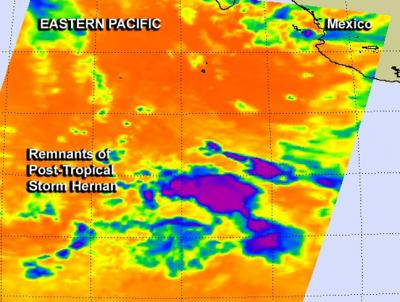NASA sees warmer cloud tops as Tropical Storm Hernan degenerates

This false-colored infrared image on July 29 at 5:11 a.m. EDT from NASA's Aqua satellite shows small, fragmented areas of a few powerful thunderstorms with high, cold (purple) cloud tops in Tropical Storm Hernan. Credit: NASA JPL, Ed Olsen
The Atmospheric Infrared Sounder or AIRS instrument aboard Aqua gathered infrared data on a quickly weakening Hernan on July 29 at 5:11 a.m. EDT.
The data was then made into a false-colored image at NASA's Jet Propulsion Laboratory in Pasadena, California. The AIRS image showed small, fragmented areas of a few powerful thunderstorms with high, cold cloud tops in Tropical Storm Hernan as it continued weakening.
For the most part, however, the cloud top temperatures warmed through the system which indicated the uplift was weaker.
By 11 a.m. EDT (1500 UTC) Hernan was no longer a tropical cyclone and had become a remnant low pressure area. The center of post-tropical cyclone Hernan was located near latitude 23.5 north and longitude 121.1 west, about 710 miles (1,145 km) west of the southern tip of Baja California, Mexico.
The post-tropical cyclone is moving toward the west-northwest near 15 mph (24 kph) and this general heading with a decrease in forward speed is expected through Wednesday night, July 30. Maximum sustained winds are near 35 mph (55 kph).
The National Hurricane Center expects that remnant low to dissipate during the next couple of days.
Media Contact
All latest news from the category: Earth Sciences
Earth Sciences (also referred to as Geosciences), which deals with basic issues surrounding our planet, plays a vital role in the area of energy and raw materials supply.
Earth Sciences comprises subjects such as geology, geography, geological informatics, paleontology, mineralogy, petrography, crystallography, geophysics, geodesy, glaciology, cartography, photogrammetry, meteorology and seismology, early-warning systems, earthquake research and polar research.
Newest articles

High-energy-density aqueous battery based on halogen multi-electron transfer
Traditional non-aqueous lithium-ion batteries have a high energy density, but their safety is compromised due to the flammable organic electrolytes they utilize. Aqueous batteries use water as the solvent for…

First-ever combined heart pump and pig kidney transplant
…gives new hope to patient with terminal illness. Surgeons at NYU Langone Health performed the first-ever combined mechanical heart pump and gene-edited pig kidney transplant surgery in a 54-year-old woman…

Biophysics: Testing how well biomarkers work
LMU researchers have developed a method to determine how reliably target proteins can be labeled using super-resolution fluorescence microscopy. Modern microscopy techniques make it possible to examine the inner workings…





















